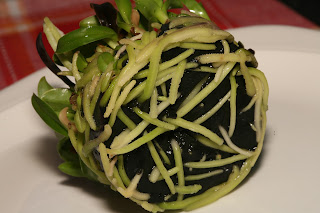On Thursday, we both went to the
EPOS meeting in Port Elizabeth, which had moved venues as the previous one had become unavailable. Unfortunately, the directions in the newsletter weren't quite accurate, so a bit of driving around was required before we found it; not being denizens of PE, out grasp of the place outside of a few shopping malls and the like is limited!
It was time for the Annual General Meeting - being such new members, we felt a little out of our depth, but the proceedings went by quite quickly, with most of the current committee re-elected. The finances also look very healthy!
After that, we had a slide show by Hendrelien Peters who is based somewhere near Durban. Her talk was entitled "Orchids Down Under" and was filled with pictures of orchids that an acquaintance (a South African emigre) had sent her of how things are done in Australia. I didn't make a list of all the different plants therein, but people seemed most impressed with the
Cymbidiums and how well they were being grown. My girlfriend often whispered which ones she liked in my ear; "We can have one of those" are always pleasing words. She's not into naming things, so it's my job to keep track of such details...!
We entered the monthly raffle (which gives you a chance of winning a plant) - Sharli's number came up first, so she had to choose between one of two
Cymbidiums or a
Phaius; the
Phaius has flower spikes about 2.5m tall (apparently) so that wasn't a good fit for OOAB! The other club members suggested a
Cymbidium, so we now add
Cymbidium 2478 (Mighty Sensation x Golden Tiger 'Easter Emerald' 4n) to our little collection!
 |
Cymbidium 2478
(Mighty Sensation x Golden Tiger 'Easter Emerald' 4n) |
Part of the monthly meetings is the "Plant Table", where club-members bring any along plants they wish to for judging (and admiration by fellow orchid-maniacs!); after much discussion between taking the
red Cattleya and the
albino Maudiae Paph, we decided to take along our
Paphiopedilum Onyx, which has recently opened a flower and has another one on its way and has very attractive mottled leaves.We were quite heavily laden on our way in, as I had volunteered to supply some treats for tea-time at the previous meeting - orchid in one hand, cakes in the other!
 |
Paphiopedilum Onyx
This is actually two plants in two half-moon pots. |
|
 |
Paphiopedilum Onyx
Close-up of new flower |
 |
Paphiopedilum Onyx
You can't see it in this picture,
but there is another flower developing behind this one.
Multifloral Paphs, FTW! |
We didn't win any prizes for it (not surprising!), but we got some useful tips about potting it on and so on; these plants have an annoying habit of growing so that the new growths are staggered upwards from the old ones, getting further and further from the potting mix, apparently an adaptation to growing up the bottom of tree stumps and rocky slopes and the like. The visiting judge wasn't too impressed with the wonky stem (and I imagine my cable-tied stake extension using a kebab skewer wasn't much admired either). We're thinking about creating a sloping pot to keep it in! The prize-winners were all
Cattleyas, if memory serves. I find many
Cattleyas a little bit too "showy" - almost as if they're trying too hard and have too much make-up on! There weren't quite as many plants on display this month as there were last month, but there were some gems. With the other stuff in tow, I didn't feel like also lugging all my camera gear down, so I'm afraid there are no photos. If you want to see pictures of last month's winners, they're available on the last page of the
EPOS February Newsletter. Another useful tip we picked up was to only attempt staking and flower manipulations in the middle of the day, when the stems and stalks are apparently at their most flexible. Good to know!
We came away (unsurprisingly) wanting more plants; on display were two lovely little
Pleurothallids, a deep pink
Stelis argentata (syn. vulcanica) and a
Restrepia falkenbergii, which are officially sanctioned for entry into the OOAB collection, as are Antelope-group Dendrobiums. Interestingly, you can grow "cuttings" of most
Restrepia just like you would an African Violet - gently pull a leaf off the plant (with as long a petiole as you can manage), pop the petiole in some damp river sand with the leaf poking up, and you'll soon have more plants; they often frequently grow keikis from there naturally; this specimen had a few, which someone suggested the owner should keep an eye on, just in case they went walking...! One of the joys of Pleurothallids is they're mostly quite small; a bonus if your growing area is small. I hoped this permission/recognition of planty greatness meant immediate acquisition, but my partner pointed out that it was long-term "when we actually have space those are quite nice" rather than "get thee on the internet and make the purchase forthwith" permission!
We now await next month's meeting...






























































